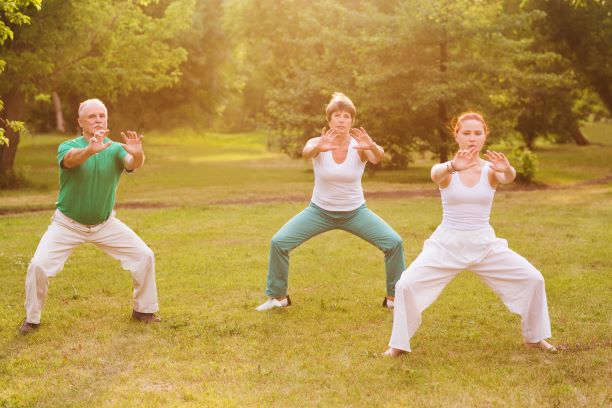Your arthritis pain can be treated with exercise. Many forms of exercise have proven effective for arthritis. These include aerobic exercise, strength training, stretching, and balance training. You need to choose the type of exercise that resonates most with you. Then stick with it. Mind-body exercise is another effective type of treatment for people with arthritis. This article discusses how your mind-body connection influences your pain. We offer suggestions so you can manage your arthritis for optimal physical and psychological health.
Mindfulness involves focusing your awareness on the present moment. It acknowledges and non-judgmentally accepts your feelings, thoughts, and bodily sensations. Mediation is an effective practice to promote this state. Mindfulness is associated with better pain coping skills, greater physical activity, and greater weight loss from exercise. Importantly, difficulties coping with pain are a big barrier to adhering to an exercise program. If you struggle coping with your pain, mind-body exercise, such as Yoga and Tai Chi, are excellent options for you.
Yoga for Knee Arthritis
People with knee arthritis who demonstrate higher mindfulness scores achieve greater benefits from exercise. The most important component of mindfulness seems to be the ability to engage fully in activities in the present moment. Yoga is a form of mind-body exercise that incorporates the acting-with-awareness facet of mindfulness. Yoga combines mental focus with breathing techniques, stretching, and strengthening exercises. It provides relaxation benefits and reduces your stress. It is also a proven way to decrease your pain.
A 2016 study out of the University of Minnesota compared the effects of yoga to an aerobic and strengthening program in 84 people with knee arthritis. After 8 weeks, both groups showed large improvements in pain, strength, anxiety, and fear of falling. However, the people who performed yoga did slightly better in most areas. The findings of this study support the Arthritis Foundation’s recommendation for yoga as part of a regular arthritis treatment program.
Starting Your Yoga Program
When first starting out, it is best to get some help from an instructor. You can try taking a class once per week for a few months. Practice at home another 2 or 3 days per week. Then you can either continue fully on your own at home or stick with regular group classes. Some people prefer the expert instruction and social aspect of exercising in a group. Other people do better at home. It’s up to you.
It’s important to select yoga poses that challenge you but are not outside of your capabilities. Some pain is acceptable. Remember to focus your thoughts and feelings on the present moment, not the possibility of pain. Concentrate on each breath, and your sensitivity to pain will decrease. The following yoga poses are a great starting point for anyone with knee arthritis and new to yoga. If needed, use a chair close by for balance. Start with holding each pose for 5 seconds, which is about 1 slow deep breath. As you become stronger, increase how long you hold each pose (3 breaths or more).
Tai Chi for Knee Arthritis
Tai Chi is a traditional Chinese mind–body practice that combines meditation with slow, gentle, graceful movements. It also incorporates deep breathing and relaxation, similar to yoga. Tai Chi offers physical and psychological benefits. It results in improved quality of life for many people with arthritis. It is also less physically demanding than other forms of exercise, and this makes it a very popular option.
A 2016 study in the Annals of Internal Medicine compared the benefits of Tai Chi to physical therapy treatment for people with knee arthritis. After 12 weeks, both groups showed similarly large improvements in pain, function, walking ability, depression scores, and overall well-being. This study suggests Tai Chi is an effective treatment option for people with arthritis. In particular, Tai Chi is a viable option for people seeking a group exercise experience. Those looking for more individualized exercise instruction would be better off working with a physical therapist to start.
Getting Started with Tai Chi
Similar to starting off with yoga, it is a good idea to seek out a qualified Tai Chi instructor. Stafford Township holds group sessions at the Bay Avenue community center. Once you learn the basics, you can develop a routine for home or continue with the group. Also, physical therapists often incorporate components of Tai Chi into balance training for their patients.
Tai Chi involves moving from one pose flowing into the next. The body remains in constant motion. It’s low-impact, so it puts minimal stress on your muscles and joints. This makes it safe and appealing for most people with arthritis. Tai Chi is also appealing because no special equipment is needed. There are different styles of Tai Chi. The video that follows shows a few basic Tai Chi poses to get you started. Dr. Paul Lam is a physician and world-renowned expert in Tai Chi. His programs are designed specifically for people with Arthritis.
Mind-Body Exercise for Arthritis: Take the Next Step
Arthritis pain can impact your physical and psychological well-being. You may start to avoid long walks, limit your social outings, and become depressed over your pain. You can change this. Mind-body exercises can help you. Take a local group class to get started (Yoga or Tai Chi).
If you don’t feel like you can do it alone, call your physical therapist. The physical therapists at BSR are committed to helping you move without pain. Exercise is the first treatment for arthritis before resorting to drugs, injections, or surgery. We want to help you take back control of your health.


